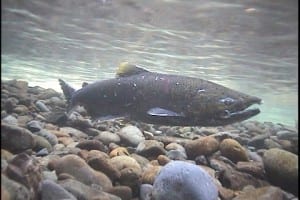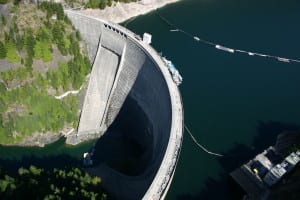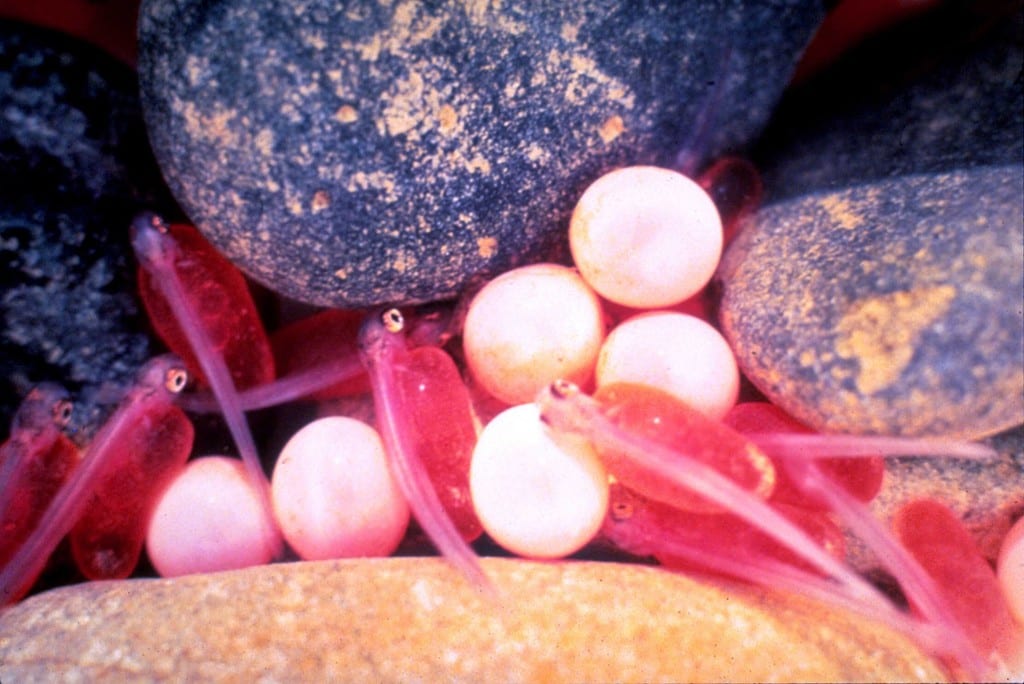 Many Chinook salmon eggs laid in the Skagit River system last fall faced grim prospects for survival amid challenging water conditions. But a coordinated effort by Seattle City Light working with state and federal resource agencies and tribes along with an exceptionally wet March and April gave more than 300,000 of them the chance to grow up.
Many Chinook salmon eggs laid in the Skagit River system last fall faced grim prospects for survival amid challenging water conditions. But a coordinated effort by Seattle City Light working with state and federal resource agencies and tribes along with an exceptionally wet March and April gave more than 300,000 of them the chance to grow up.

Summer Chinook salmon spawn in the Skagit river from August through October each year — Photo by Dave Bickford, courtesty of U.S. Forest Service
Many Chinook salmon eggs laid in the Skagit River system last fall faced grim prospects for survival amid challenging water conditions. But a coordinated effort by Seattle City Light working with state and federal resource agencies and tribes along with an exceptionally wet March and April gave more than 300,000 of them the chance to grow up.
“From November through February, this appeared to be one of the worst water years we had seen in quite a while. It was some great teamwork and a huge increase in precipitation in March and April that really turned things around,” said Dave Clement, Resource Planning, Forecasting, and Analysis Director for City Light.
Chinook salmon spawning season typically lasts from mid-August to mid-October each year. This past September, during the peak of spawning activity, record rainfall levels allowed chinook salmon to dig nest sites in areas that would be dry when water levels returned to normal.
The summer Chinook salmon are a federally-listed species with Endangered Species Act protection. But dry weather conditions from November 2013 through February of this year meant those salmon eggs were likely to be left out to dry and die.
“The situation required the release of far more water from the hydro project than we had originally planned so as to protect as many of the salmon nest sites as possible,” explained David Pflug, fisheries biologist at City Light.
City Light manages flow levels in the Skagit River system to meet a several key objectives each year: protecting fish that live and spawn in the river downstream, generating sufficient power to meet the energy needs of our customers throughout the year, preventing floods downstream of the dams and keeping the river and Ross Lake at elevations that permit recreation such as boating and fishing. In addition, Ross Lake serves an important function as a reservoir to hold water that is used to generate electricity in drier times during the year.
The trick is managing the right water levels for each of these objectives, while working with highly variable precipitation levels that are ultimately decided on by Mother Nature.
That’s the situation City Light found itself in earlier this year. The region had one of the lowest levels of precipitation in more than a decade from November to February, and was facing perhaps one of the worst water years in history.

Ross Dam on the Skagit River creates Ross Lake, which is full for summer recreation and hydropower generation.
Pflug works closely with the utility’s Resource Planning staff, who plan optimum water levels. He discovered that there were many Chinook salmon redds spawned high on the riverbank in September during the rainy spawning season. The dry weather conditions during winter meant it would be difficult to protect the redds under normal operations.
That information went to the Skagit Project Flow Coordinating Committee comprised of state, federal fisheries resource agencies and tribe. City Light’s Resource Planning team worked with the committee to come up with a plan to protect the nest sites, which required the release of additional water and taking the risk of not being able to refill Ross Lake for use later in the year. With the survival of the Chinook at stake, the plan was approved.
City Light kept the river flow levels up to protect the salmon nests from November of 2013 to May of 2014. It took a significant amount of teamwork, including daily monitoring of water elevation levels and careful management to ensure the protection of the nests. Coordination between multiple divisions ensued, including Pflug, Power Management planners Ole Kjosnes and Don Tinker, the Power Marketing team and the System Control Center team. Continuing dry conditions also worried resource planners about the ability refill Ross Lake, which powers Ross Dam through the summer and is a key recreational area within the North Cascades National Park complex.

These graphs show the cumulative snowpack and precipitation levels, measured in inches. The blue line is the average level, while the green line tracks the dry water year of 2014. The yellow line, by way of comparison, measures levels during the severe dry spell of water year 2001.
Then came the wettest March in history.
And more precipitation in April.
That rain and the snow that fell higher up in the mountains provided the water for City Light to protect the redds and refill the lake. This voluntary effort resulted in the protection of 31 nest sites that would have otherwise been lost– a resounding success, especially considering their initial odds of survival.
Those 31 redds add up to approximately 300,000 protected salmon eggs.
A full Ross Lake will allow for increased river flows through July, enabling better protection of Steelhead that will be spawning the Skagit River and additional energy generation from City Light’s Ross, Diablo and Gorge hydroelectric dams.
“It was a good thing we released more water than we normally would have – because that made room in Ross Lake to collect more of the large amount of water that came in March and April and avoided some spill through the spill gates,” Clement said. “So in a way, the fish helped us out, too.”
Seattle City Light is the 10th-largest public electric utility in the United States. It has some of the lowest cost customer rates of any urban utility, providing reliable, renewable and environmentally responsible power to nearly 750,000 Seattle-area residents. City Light has been greenhouse gas neutral since 2005, the first electric utility in the nation to achieve that distinction. More information at: http://www.seattle.gov/light/
